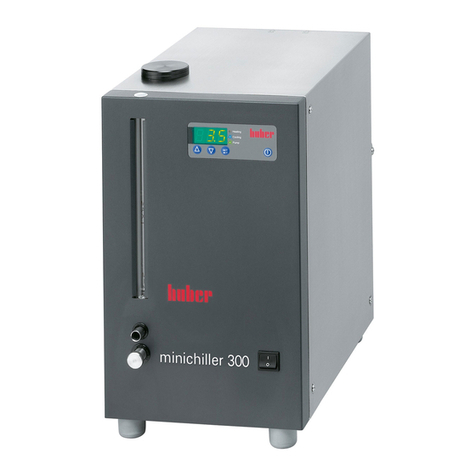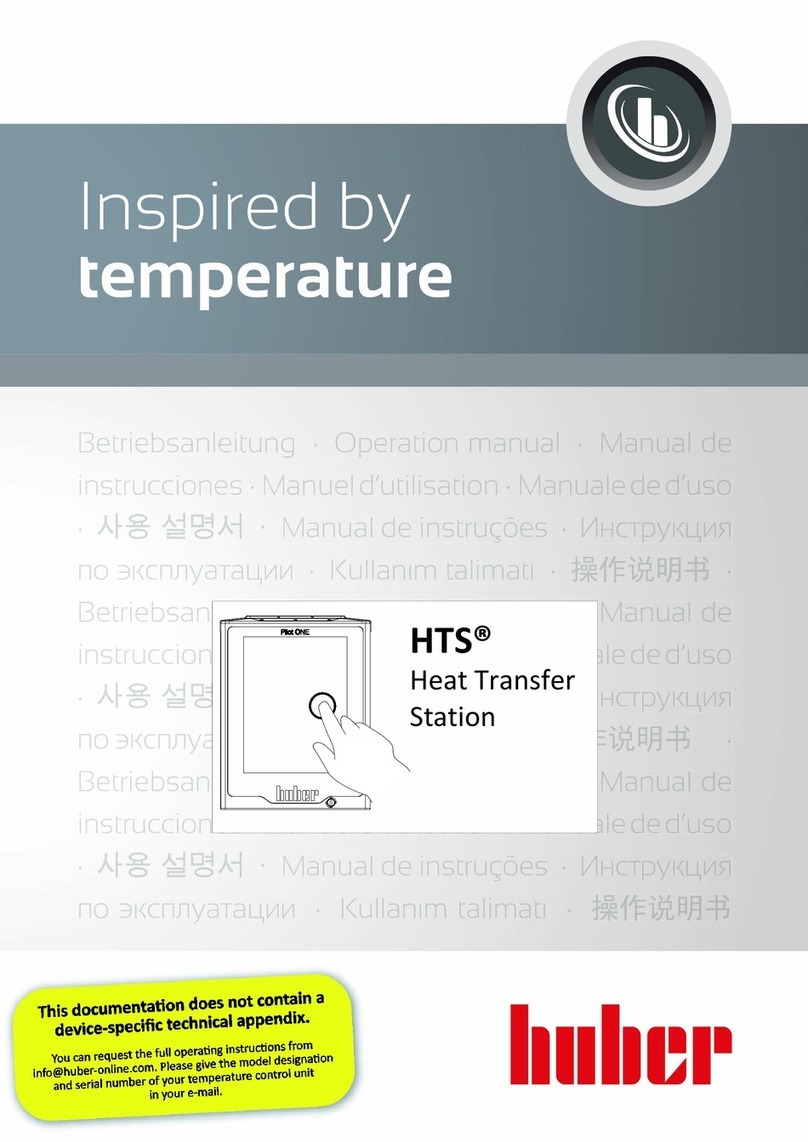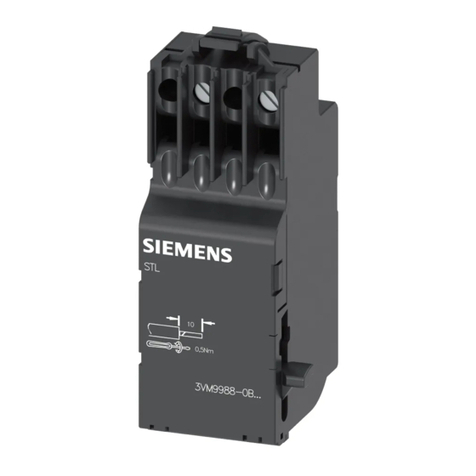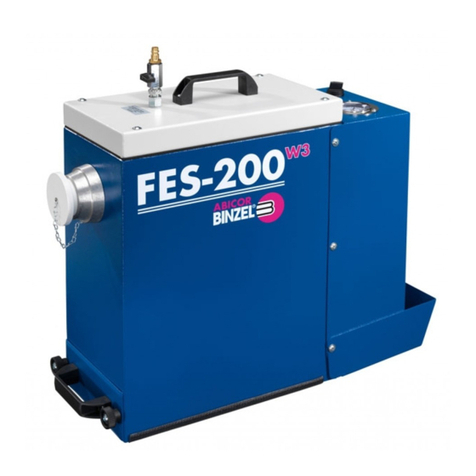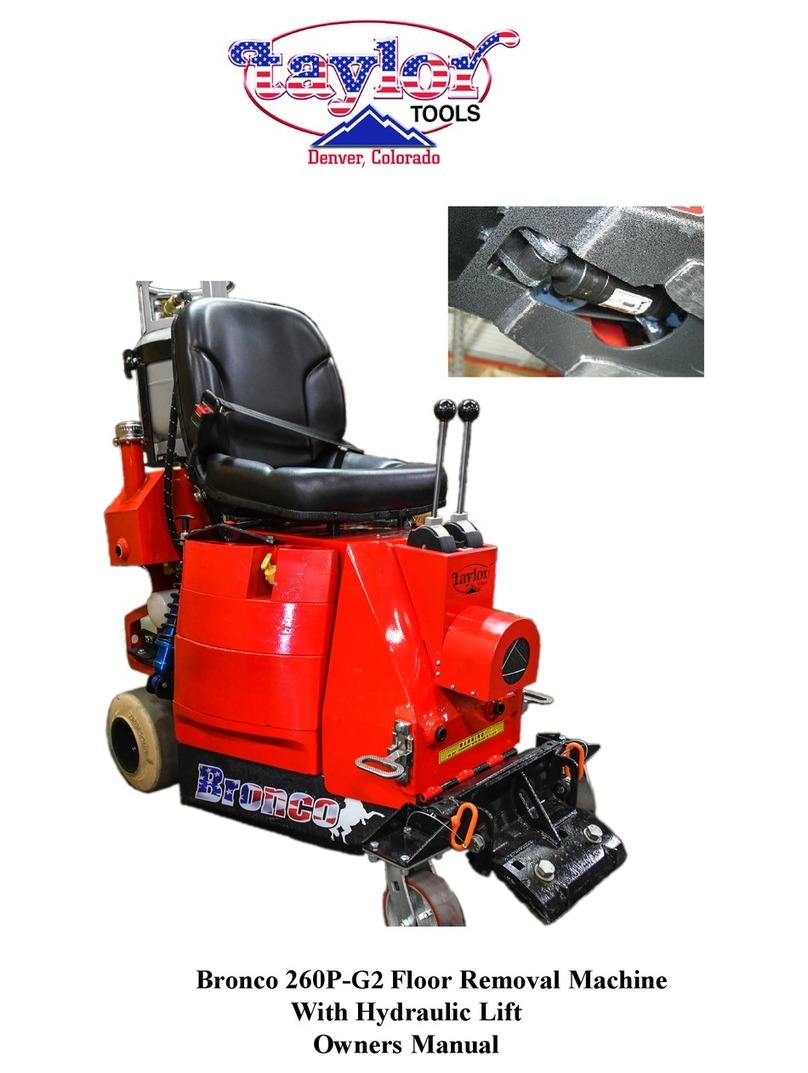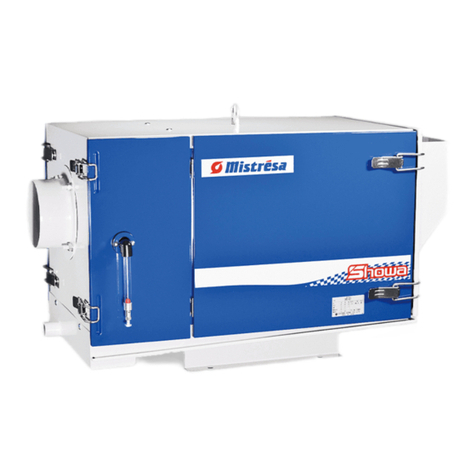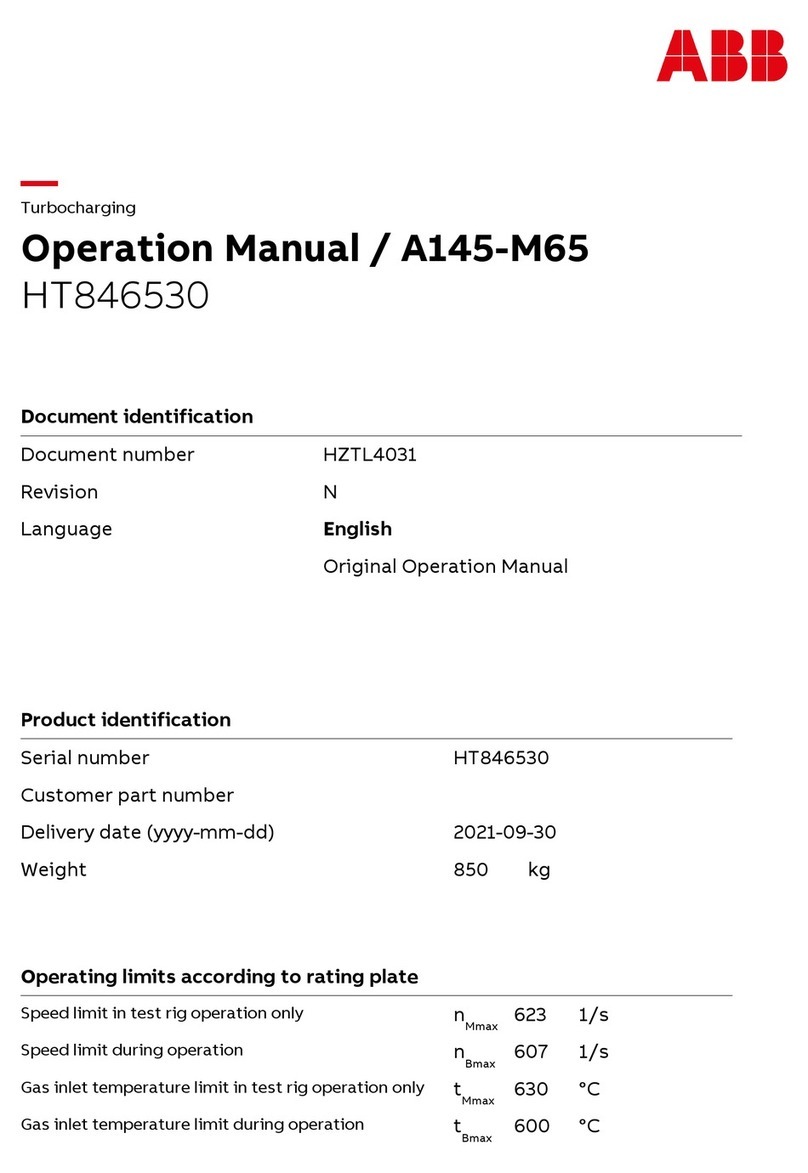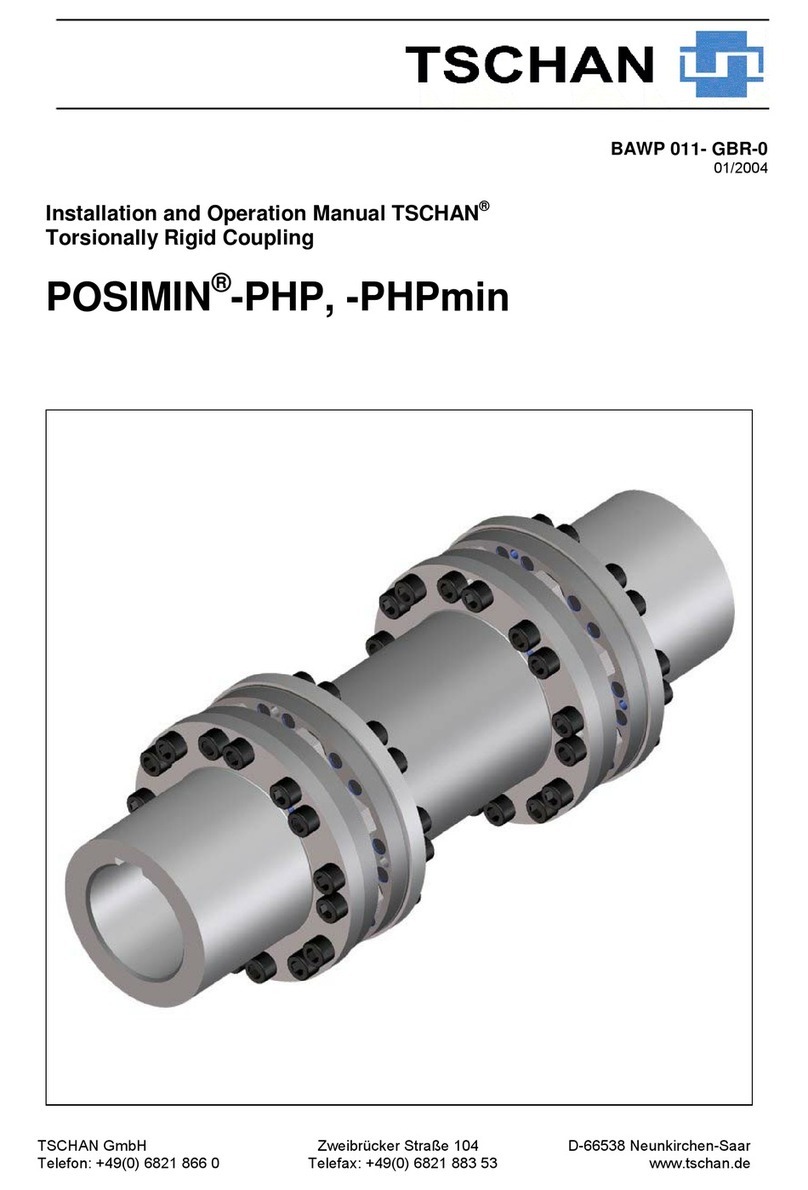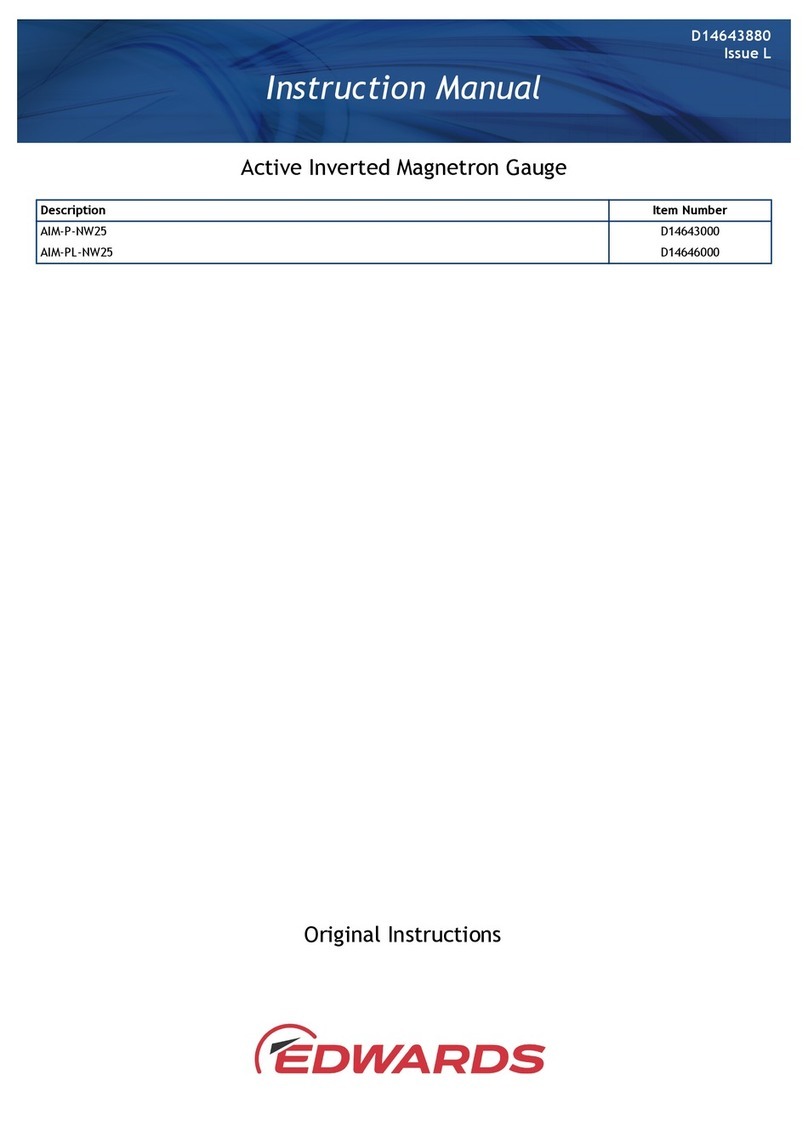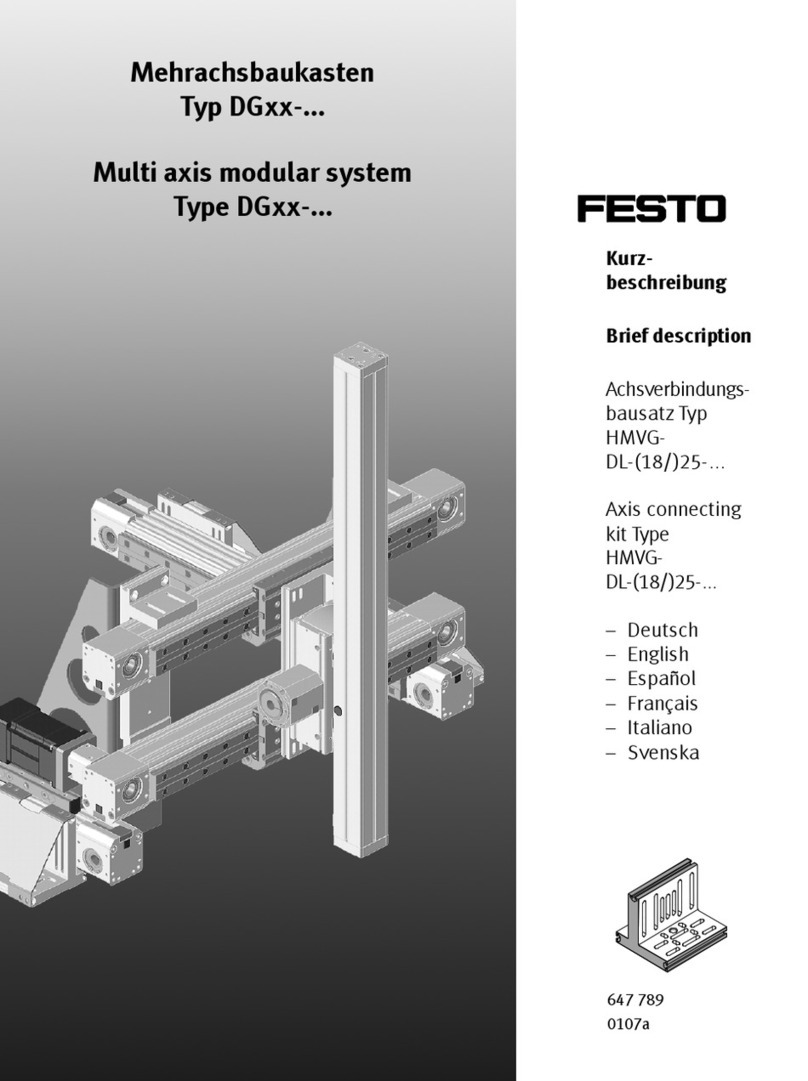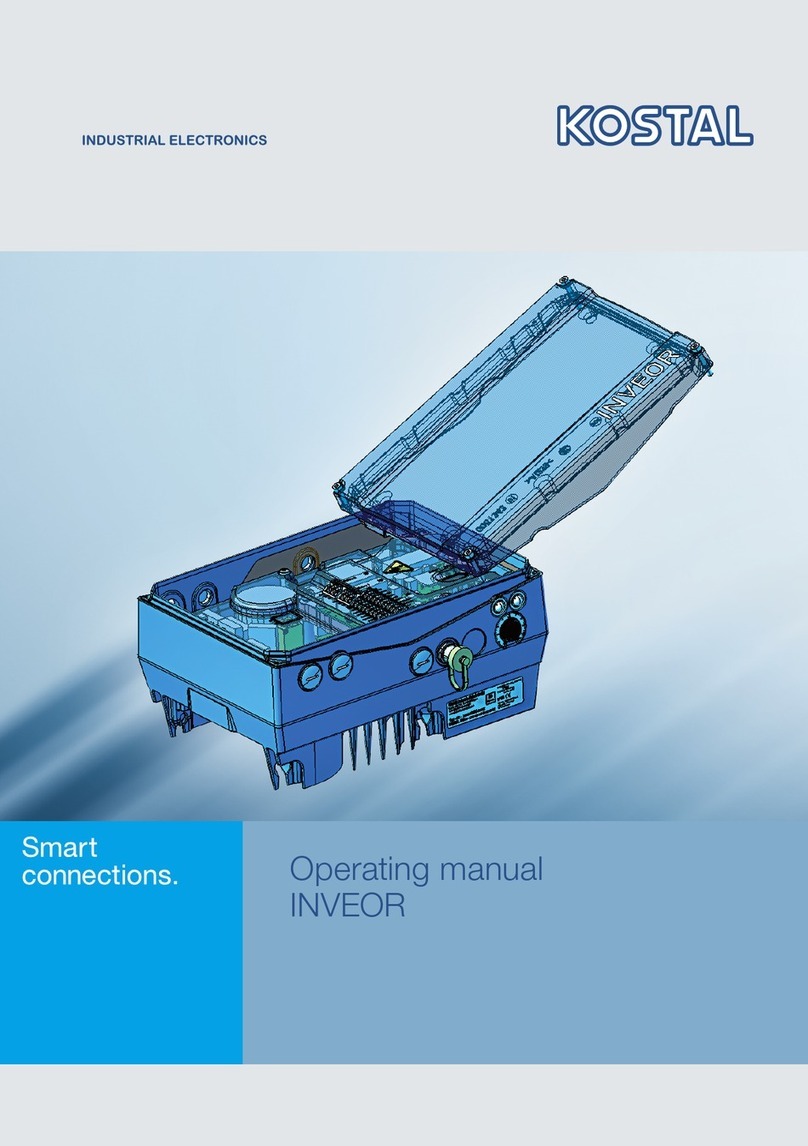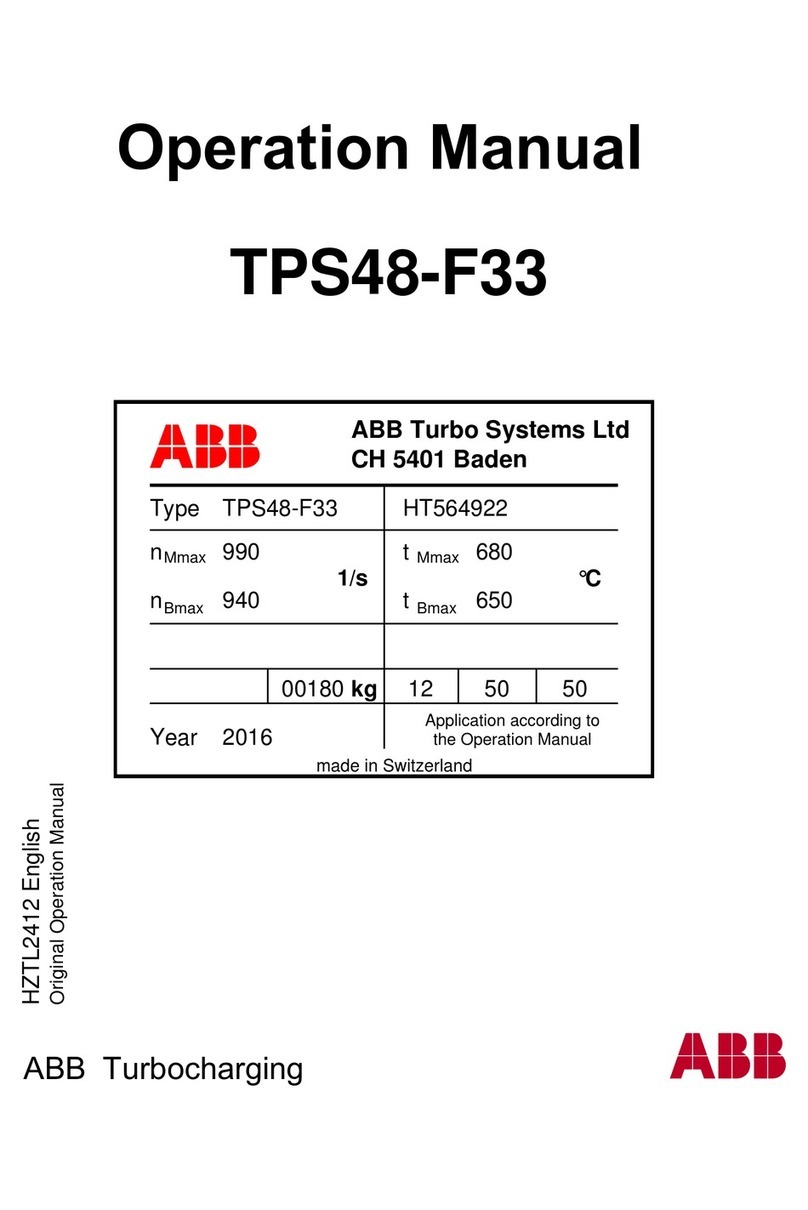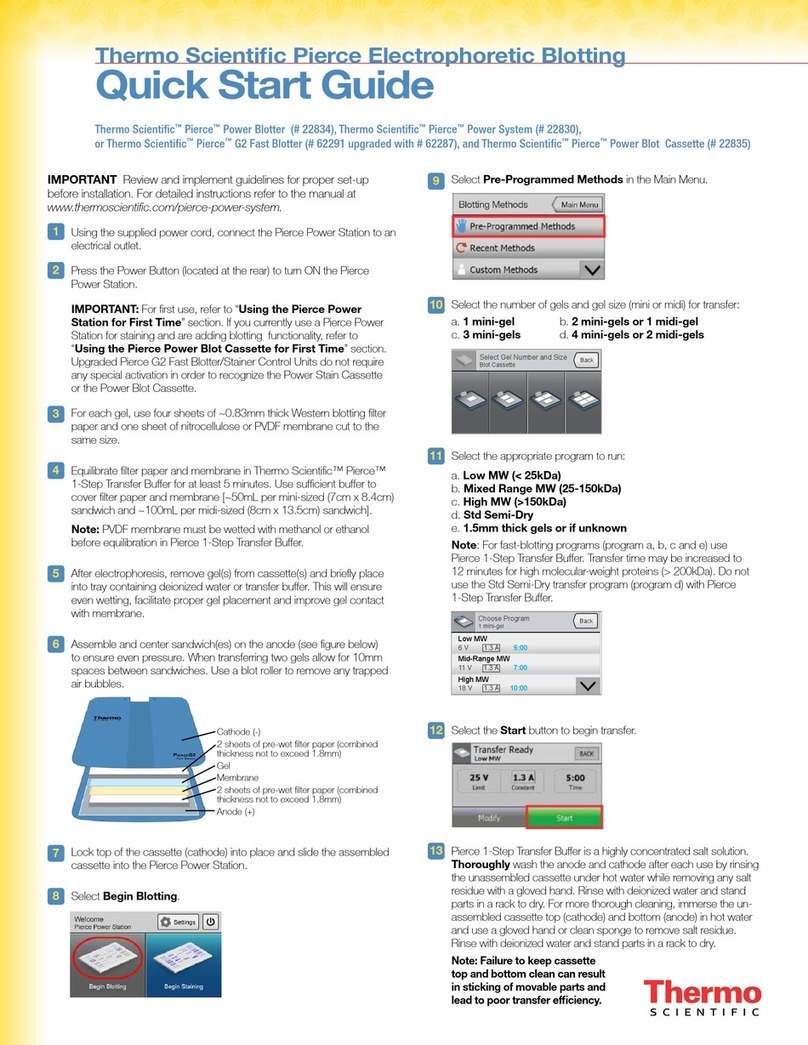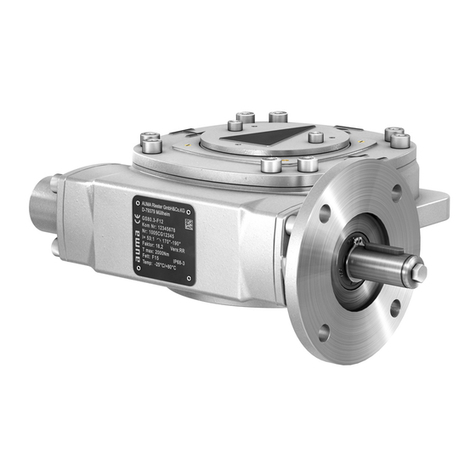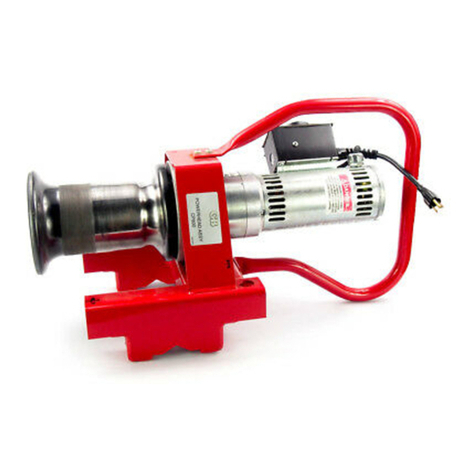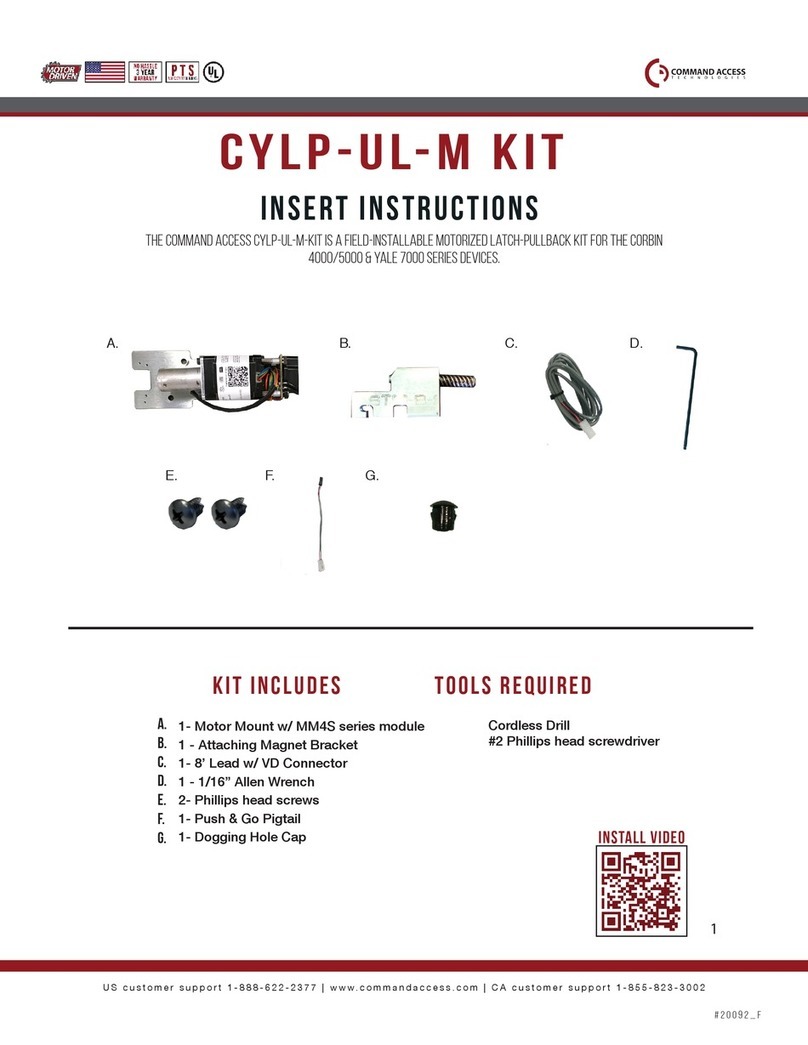Huber Pilot ONE Unistat T300 Series User manual

Unistat®
T300Series
V1.2.0
OperationManual
This documentaon does not contain a
device-specific technical appendix.
You can request the full operang instrucons from
info@huber-online.com. Please give the model designaon
and serial number of your temperature control unit
in your e-mail.


OPERATIONMANUAL
Unistat®
T300Series
V1.2.0


OPERATION MANUAL
V1.2.0en/12.05.15//14.06 Liability for errors and misprints excluded. Unistat® T300 Series
5
Unistat®
T300 Series
This operation manual is a translation of the original operation manual.
VALID FOR:
TABLE-TOP MODELS
Unistat® T305 (HT, w HT)
FREE-STANDING MODELS
Unistat® T305 (HT, w HT)

OPERATION MANUAL
Unistat® T300 Series Liability for errors and misprints excluded. V1.2.0en/12.05.15//14.06
6
“Unistat Control ONE“
and „Pilot ONE“
Description of the
LEDs in the flow dia-
gram
Components illustrat-
ed in the
LED flow diagram

OPERATION MANUAL
V1.2.0en/12.05.15//14.06 Liability for errors and misprints excluded. Unistat® T300 Series
7
Layout of the “Home”
screen

OPERATION MANUAL
Unistat® T300 Series Liability for errors and misprints excluded. V1.2.0en/12.05.15//14.06
8
Table of contents
V1.2.0en/12.05.15//14.06
1Introduction 14
1.1 Details on the declaration of conformity....................................................... 14
1.2 Safety .......................................................................................................... 14
1.2.1 Symbols used for Safety Instructions..............................................................14
1.2.2 Proper operation.............................................................................................15
1.2.3 Reasonably foreseeable misuse......................................................................16
1.3 Responsible bodies and operators – Obligations and requirements............... 16
1.3.1 Obligations of the responsible body ...............................................................16
1.3.2 Requirements for operators ...........................................................................16
1.3.3 Obligations of the operators...........................................................................16
1.4 General information..................................................................................... 17
1.4.1 Description of workstation .............................................................................17
1.4.2 Safety devices to DIN 12876 ...........................................................................17
1.4.3 Further protective devices ..............................................................................18
1.4.3.1 Power interruption.....................................................................................18
1.4.3.2 Alarm functions ..........................................................................................18
1.4.3.3 Warning messages......................................................................................18
2Commissioning 19
2.1 In-plant transport......................................................................................... 19
2.2 Unpacking.................................................................................................... 19
2.3 Ambient conditions...................................................................................... 19
2.4 Installation conditions.................................................................................. 21
2.5 Temperature control unit for outdoor installation incl. winter operation ...... 21
2.6 Recommended temperature control and cooling water hoses ...................... 22
2.7 Wrench sizes and torques............................................................................. 22
2.8 Temperature control units with water cooling.............................................. 23
2.9 Preparations for operation ........................................................................... 24
2.9.1 Opening/closing valves ...................................................................................24
2.9.2 Mounting/removing the isolating sleeve (optional) .......................................24
2.9.2.1 Mounting the Isolating sleeve (only for externally open applications)......24
2.9.2.2 Removing the Isolating sleeve (only for externally closed applications)....25
2.10 Connecting externally closed/open application ............................................ 25
2.10.1 Connecting an externally closed application ..................................................25
2.10.2 Connecting an externally open application (bath)..........................................26
2.11 Connecting to the power supply ................................................................... 26
2.11.1 Connection using socket with protective earth (PE).......................................26
2.11.2 Connection via direct wiring ...........................................................................27
2.11.3 Converting the power supply connection.......................................................27
3Function description 28
3.1 Function description of the temperature control unit ................................... 28
3.1.1 General functions............................................................................................28
3.1.2 Other functions...............................................................................................28
3.2 Information on the thermal fluids ................................................................ 29
3.3 To be noted when planning the test ............................................................. 30
3.4 “Pilot ONE®” controller ................................................................................ 31

OPERATION MANUAL
V1.2.0en/12.05.15//14.06 Liability for errors and misprints excluded. Unistat® T300 Series
9
3.4.1 Functional overview of “Pilot ONE®” ..............................................................31
3.5 Unistat® LED diagram ................................................................................... 33
3.6 Clock/event function.................................................................................... 33
3.6.1 Rechargeable accumulator .............................................................................33
3.6.2 Programmable event function ........................................................................33
3.6.2.1 Event function “Alarm clock event” ...........................................................33
3.6.2.2 Event function “Program event” ................................................................34
3.7 Operation via the touch screen..................................................................... 34
3.8 Display instruments ..................................................................................... 34
3.8.1 The touchscreen [88] ......................................................................................34
3.8.2 The LED-Indicator Temperature [90] ..............................................................34
3.8.3 The LED-Indicator Flow Chart [91] ..................................................................35
3.8.4 The LED-Indicator Status [92] .........................................................................35
3.9 Control instruments ..................................................................................... 35
3.9.1 The touchbuttons............................................................................................35
3.9.2 The categories.................................................................................................35
3.9.3 The sub-categories..........................................................................................35
3.9.4 The dialogs ......................................................................................................36
3.10 Function examples ....................................................................................... 36
3.10.1 Display of software version.............................................................................36
3.10.2 Start & Stop.....................................................................................................36
3.10.3 Restore factory settings ..................................................................................37
3.10.3.1 Restore to factory settings without overtemperature protection .............40
3.10.3.2 Restore to factory settings including overtemperature protection ...........40
4Setup mode 41
4.1 Setup mode ................................................................................................. 41
4.1.1 Turning on the temperature control unit .......................................................41
4.1.2 Setting the overtemperature protection ........................................................41
4.1.2.1 General information on the overtemperature protection .........................42
4.1.2.2 Setting “OT limit: heating” .........................................................................42
4.1.2.3 Setting “OT expansion vessel”....................................................................43
4.1.2.4 Setting “Process Safety” .............................................................................43
4.1.2.5 Monitoring via “Display OT values”............................................................43
4.1.3 Testing overtemperature protection for functionality ...................................44
4.1.4 Adjusting the Delta T limiter ...........................................................................44
4.1.4.1 Changing the Delta T limiter.......................................................................44
4.2 The temperature control circuit.................................................................... 44
4.2.1 Select temperature control: Internal or process ............................................45
4.2.2 Temperature control to internal temperature ...............................................45
4.2.3 Temperature control to process temperature................................................46
4.2.4 Delta T limiter .................................................................................................46
4.2.5 Monitoring the Pt100 temperature sensors...................................................46
4.2.6 Optimum control parameters for optimum temperature control..................47
4.2.7Sub-category: “Select auto/expert mode”......................................................47
4.2.8 Sub-category: “Configuration auto” ...............................................................47
4.2.8.1 Sub-category: “Find parameters”...............................................................47
4.2.8.2 Sub-category: “Control Dynamics”.............................................................49
4.2.8.3 Sub-category: “Fluid Properties”................................................................51
4.2.8.4 Sub-category: “Display parameters” ..........................................................52
4.2.9 Category: “Configuration manual”..................................................................52
4.2.9.1 Sub-category: “Change parameters”..........................................................52

OPERATION MANUAL
Unistat® T300 Series Liability for errors and misprints excluded. V1.2.0en/12.05.15//14.06
10
4.2.9.2 Sub-category: “Display parameters” ..........................................................53
4.2.9.3 Sub-category: “Control structure”..............................................................53
4.2.10 Sub-category: “Reset parameters” .................................................................54
4.2.11 Sub-category: “Display parameters”...............................................................54
4.2.12 Setting the setpoint thresholds ......................................................................54
4.2.13 Setting the setpoint ........................................................................................55
4.3 Adjusting the cooling capacity ...................................................................... 55
4.3.1 Cooling water connection I .............................................................................56
4.3.1.1 Activating the cooling water release..........................................................56
4.3.2 Cooling water connection II ............................................................................57
4.4 Filling, venting, degassing and draining......................................................... 57
4.4.1 Externally closed application ..........................................................................57
4.4.1.1 Filling and venting externally closed application........................................58
4.4.1.2 Degassing externally closed applications ...................................................59
4.4.1.3 Draining externally closed applications......................................................61
4.4.2 Externally open application ............................................................................62
4.4.2.1 Filling and venting externally open application..........................................62
4.4.2.2 Degassing externally open applications .....................................................63
4.4.2.3 Draining externally open applications........................................................64
5Normal operation 66
5.1 Automatic operation .................................................................................... 66
5.1.1 Temperature control.......................................................................................66
5.1.1.1 Starting the temperature control process..................................................66
5.1.1.2 Ending the temperature control process ...................................................66
5.1.2 Temperature control via a created temperature control program ................67
5.1.2.1 Starting the temperature control program ................................................67
5.1.2.2 Ending/cancelling the temperature control program ................................67
6Interfaces and software update 68
6.1 Interfaces at the “Pilot ONE®” controller ...................................................... 68
6.1.1 10/100 Mbps Ethernet for RJ45 network sockets ..........................................68
6.1.2 USB-2.0 interface ............................................................................................69
6.1.2.1 USB-2.0 interface, host...............................................................................69
6.1.2.2 USB-2.0 interface, device ...........................................................................69
6.2 Interfaces at the “Unistat® Control ONE”...................................................... 69
6.2.1 Interfaces at the “Unistat® Control ONE” side................................................69
6.2.1.1 Removing the cover....................................................................................69
6.2.1.2 Jack ECS ONE (External Control Signal) standby.........................................69
6.2.1.3 Conccector POKO ONE (floating contact) alarm.........................................70
6.2.2 Interfaces at the “Unistat® Control ONE” top side .........................................71
6.2.2.1 Service interface.........................................................................................71
6.2.2.2 Female RS232 Serial (with adapter cable)..................................................71
6.2.2.3 Connection jack for Pt100 process controller sensor.................................72
6.3 Interfaces at the Com.G@te® (optional) ....................................................... 72
6.3.1 Jack LEVEL (Com.G@te® external only) ..........................................................73
6.3.2 Connector POKO (floating contact) alarm ......................................................73
6.3.3 Jack AIF Reg-E-Prog.........................................................................................74
6.3.4 Jack ECS (External Control Signal) standby .....................................................74
6.3.5 Jack RS232/RS485 serial..................................................................................75
6.4 Firmware update.......................................................................................... 75
7Service/maintenance 76

OPERATION MANUAL
V1.2.0en/12.05.15//14.06 Liability for errors and misprints excluded. Unistat® T300 Series
11
7.1 Messages from the temperature control unit ............................................... 76
7.2 Replacing the “Pilot ONE®” or “Unistat® Control ONE” ................................. 76
7.2.1 Replacing the “Pilot ONE®”.............................................................................76
7.2.2 Replacing the “Unistat® Control ONE”............................................................77
7.3 Maintenance................................................................................................ 77
7.3.1 Function check and visual inspection .............................................................78
7.3.2 Clean liquefier fins (air-cooled temperature control unit) .............................79
7.3.3 Clean hat-type strainer (dirt trap) (water-cooled temperature control unit).80
7.3.4 Empty the drip tray .........................................................................................80
7.4 Thermal fluid inspection, replacement and circuit cleaning........................... 81
7.4.1 Thermal fluid inspection .................................................................................81
7.4.2 Thermal fluid replacement .............................................................................81
7.4.2.1 Externally closed application......................................................................81
7.4.2.2 Externally open application........................................................................81
7.4.3 Cleaning the thermal fluid circuit....................................................................82
7.5 Cleaning the surfaces ................................................................................... 83
7.6 Inspect the mechanical seal.......................................................................... 83
7.7 Plug contacts................................................................................................ 83
7.8Decontamination/repairs ............................................................................. 84
8Shutting down 85
8.1 Safety instructions and basic principles ........................................................ 85
8.2 Switch-off .................................................................................................... 86
8.3 Draining-off the cooling water...................................................................... 86
8.3.1 Draining process .............................................................................................86
8.4 Packing ........................................................................................................ 86
8.5 Shipping....................................................................................................... 87
8.6 Disposal ....................................................................................................... 87
8.7 Phone number and company address........................................................... 88
8.7.1 Telephone number: Customer Support ..........................................................88
8.7.2 Telephone number: Sales ...............................................................................88
8.7.3 Email adress: Customer Support.....................................................................88
8.7.4 Service/return adress......................................................................................88
8.8 Certificate of Compliance ............................................................................. 88
9Annex 89

OPERATION MANUAL
Unistat® T300 Series Liability for errors and misprints excluded. V1.2.0en/12.05.15//14.06
12

OPERATION MANUAL
V1.2.0en/12.05.15//14.06 Liability for errors and misprints excluded. Unistat® T300 Series
13
Foreword
Dear customer,
You have opted for a temperature control unit from Peter Huber Kältemaschinenbau GmbH. You
have made a good choice. Thank you for your confidence in our products.
Read through this operation manual carefully prior to start-up. Strictly follow all notes and safety in-
structions.
Proceed with transport, start-up, operation, maintenance, repairs, storage and disposal in accor-
dance with this operation manual.
Subject to proper operation, we offer a full warranty for your temperature control unit.

Introduction
OPERATION MANUAL Chapter 1
Unistat® T300 Series Liability for errors and misprints excluded. V1.2.0en/12.05.15//14.06
14
1Introduction
1.1 Details on the declaration of conformity
The equipment complies with the basic health and safety requirements of the European Directives
listed below:
▪Machinery Directive 2006/42/EC
▪Low Voltage Directive 2006/95/EC
▪EMC Directive 2004/108/EC
1.2 Safety
1.2.1 Symbols used for Safety Instructions
Safety instructions are marked by the below combinations of pictograms and signal words. The
signal word describes the classification of the residual risk when disregarding the operation manual.
Denotes an immediate hazardous situation that will result in death or serious injuries.
Denotes a general hazardous situation that may result in death or serious injuries.
Denotes a hazardous situation that can result in injury.
Denotes a situation that can result in property material damage.
Denotes important notes and usable hints.
Notes in conjunction with Ex p cabinets.
The safety information in this operation manual is designed to protect the responsible body, opera-
tor and the equipment from damage. Safety information must always appear BEFORE instructions
and at the beginning of each chapter. You should be first informed about the residual risks due to
misuse before you begin an operation.
Safety information and
procedure

Introduction
Chapter 1 OPERATION MANUAL
V1.2.0en/12.05.15//14.06 Liability for errors and misprints excluded. Unistat® T300 Series
15
1.2.2 Proper operation
Operating the temperature control unit in a potentially explosive area
DEATH THROUGH EXPLOSION
Do NOT install or start up the temperature control unit within an ATEX zone.
Improper use
SERIOUS INJURY AND PROPERTY DAMAGE
Store the operation manual where it is easy to access in close proximity to the temperature
control unit.
Only adequately qualified operators may work with the temperature control unit.
Operators must be trained before handling the temperature control unit.
Check that the operators have read and understood the operation manual.
Define precise responsibilities of the operators.
Personal protective equipment must be provided to the operators.
Be sure to follow the responsible body’s safety rules to protect life and limb and to limit dam-
ages!
Modifications to the temperature control unit by third-parties
DAMAGE TO THE TEMPERATURE CONTROL UNIT
Do not allow third parties to make technical modifications to the temperature control unit.
In case of any modification of the temperature control unit not approved by the manufacturer,
the CE declaration of conformity becomes invalid.
Only specialists trained by the manufacturer may carry out modifications, repairs or mainte-
nance work.
The following must be observed without fail:
Only use the temperature control unit in a fault-free condition!
Have start-up and repairs carried out only by specialists!
Do not ignore, bypass, dismantle or disconnect any safety devices!
The temperature control unit must not be used for any purposes other than temperature control in
accordance with the operation manual.
The temperature control unit is manufactured for industrial use. The temperature control unit main-
tains the temperature of certain applications, including glass or metal reactors or other expedient
items in laboratories and industry. Flow-through coolers and calibration baths must be used only in
combination with Huber temperature control units. Thermal fluids suitable for the overall system
are used. The chilling and heating capacity is provisioned at the pump connections or - where pre-
sent - in the tempering bath. The technical specification of the temperature control unit is given in
the data sheet (from page 89 in section »Annex«). The temperature control unit must be installed,
configured and operated according to the handling instructions in this operating manual. Failure to
comply with the operation manual is deemed improper use. The temperature control unit conforms
to state-of-the-art technology and the recognized safety regulations. Safety devices are built into
your temperature control unit.

Introduction
OPERATION MANUAL Chapter 1
Unistat® T300 Series Liability for errors and misprints excluded. V1.2.0en/12.05.15//14.06
16
1.2.3 Reasonably foreseeable misuse
The temperature control unit is operated outside of its specifications
MATERIAL DAMAGE CAUSED BY PREMATURE AGING / MATERIAL FATIGUE OF THE PLATE HEAT
EXCHANGER
Do not permanently operate the temperature control unit together with very dynamic and
high temperature changes recurring in short intervals.
The guarantee will expire if the temperature control unit is exposed to this type of application.
Peter Huber Kältemaschinenbau GmbH offers tried and tested technical solutions for these
types of applications.
Without an Ex p cabinet, the temperature control unit is NOT protected against explosion and
must NOT be installed or put into operation within an ATEX Zone. When operating the tempera-
ture control unit in conjunction with an Ex p cabinet, the information in the annex (section ATEX
operation) must be observed and followed. This annex is only provided for temperature control
units delivered with an Ex p cabinet. If this annex is missing, please immediately contact the Cus-
tomer Support of Peter Huber GmbH Kältemaschinenbau GmbH (the telephone number is provid-
ed on page 88 section »Phone number and company address«).
The temperature control units Unistat T305, T305 HT, T305w HT do not have a plate heat exchang-
er.
Use with medical devices (e.g. in Vitro diagnostic procedure) or for direct foodstuff temperature
control is NOT permissible.
The temperature control unit must NOT be used for any purposes other than temperature control in
accordance with the operation manual.
The manufacturer accepts NO liability for damage caused by technical modifications to the temper-
ature control unit, improper handling or use of the temperature control unit if the operation manu-
al is not observed.
1.3 Responsible bodies and operators – Obligations and
requirements
1.3.1 Obligations of the responsible body
The operation manual is to be stored where it is easy to access in close proximity to the temperature
control unit. Only adequately qualified operators (e.g. chemists, CTA, physicists etc.) are permitted
to work with the temperature control unit. Operators must be trained before handling the tempera-
ture control unit. Check that the operators have read and understood the operation manual. Define
precise responsibilities of the operators. Personal protective equipment must be provided to the
operators.
1.3.2 Requirements for operators
Work on the temperature control unit is reserved for appropriately qualified specialists, who have
been assigned and trained by the responsible body to do so. Operators must be at least 18 years old.
Under 18-year olds may operate the temperature control unit only under the supervision of a quali-
fied specialist. The operator is responsible vis-a-vis third-parties in the work area.
1.3.3 Obligations of the operators
Carefully read the operation manual before operating the temperature control unit. Please observe
the safety instructions. When operating the temperature control unit, wear appropriate personal
protective equipment (e.g. safety goggles, protective gloves, non-slip shoes).

Introduction
Chapter 1 OPERATION MANUAL
V1.2.0en/12.05.15//14.06 Liability for errors and misprints excluded. Unistat® T300 Series
17
1.4 General information
1.4.1 Description of workstation
The workstation is located at the control panel in front of the temperature control unit. The work-
station is determined by the customer's connected peripheries. Accordingly, it must be designed
safe by the responsible body. The workstation design also depends on the applicable requirements
of the German occupational health and safety regulations [BetrSichV] and the risk analysis for the
workstation.
1.4.2 Safety devices to DIN 12876
The rating of your temperature control unit is stated on the data sheet in the appendix.
Rating Temperature
control fluid Technical requirements Identificationd)
I Non-combustible a) Overheat protection c) NFL
II Combustible b) Adjustable overheat protection FL
III Combustible b) Adjustable overtemperature protection
and additional low level protection FL
a) Usually water; other fluids only if non-combustible even within the temperature range of an individual fault.
b) The temperature control media must have a combustion point of ≥ 65 °C; i.e. if ethanol is used, only supervised
operation is possible.
c) The overheat protection can, for instance, can be realized using a suitable fill level sensor or a suitable
temperature limiter.
d) Optional at the choice of the manufacturer.
Combined electronic low level and overtemperature protection
This temperature control unit has been equipped with electronic overtemperature protection and
low level protection. Instead of a mechanical float switch, temperature sensors are employed on the
surface of the heating coils. These sensors monitor overtemperature at this potential ignition
source, thus ensuring that the controller regulates the heating coil temperatures regulates below
the critical temperature (combustion point of the thermal fluid). A message is displayed on the
>Touchscreen< [88].
Mechanical tools are no longer required for setting the trip values for the overtemperature protec-
tion. A software tool is used instead. The threshold value for the overtemperature protection can be
set only if a code randomly generated by “Pilot ONE” beforehand is entered correctly. As with the
mechanical tool, accidental settings are thus prevented.The type of overtemperature protection
function and of low level protection depends on the temperature control unit.
Rating of laboratory
thermostats and
laboratory baths
Overview of the tem-
perature thresholds

Introduction
OPERATION MANUAL Chapter 1
Unistat® T300 Series Liability for errors and misprints excluded. V1.2.0en/12.05.15//14.06
18
Low level protection
Low level protection is achieved via a pressure sensor in the fluid circuit. The pump ensures, togeth-
er with the thermal fluid, the requisite pressure at the pressure sensor. Air in the system (fill level
too low, inadequately vented) prevents the pressure from reaching value specified at the pressure
sensor. Temperature control and circulation are interrupted.
Process safety
This type of overtemperature protection is driven by a desire for further protection of operator and
system. Protective devices typically disconnect all poles when reaching the overtemperature protec-
tion trigger value. This may result in more heat being fed into the process (e.g. exothermic reaction)
than the existing cooling machine is able to cool as the overtemperature protection trigger value is
usually set above the controller setpoint. Turning off the temperature control unit eliminates the
possibility to extract heat from the process. The temperature could therefore rise further and sys-
tem components could be heated up above their rated temperatures, e.g. could cause danger to life
and limb by rupture of the material or phase transitions from liquid to gaseous state. Reaching the
trigger value is recognized in the Process Safety mode by the controller at the overtemperature
protection, which then releases cooling. This mode requires the compressor to be set to Permanent-
ly ON ([System Settings] > [Power/ECO Settings] > [Compressor ON/OFF/AUTO] > [Permanently
ON]). Even if the temperature continues to rise, the cooling machine will use its maximum cooling
capacity to keep any further increase in temperature as low as possible. You must observe page 41
of section »Setting the overtemperature protection«.
1.4.3 Further protective devices
Emergency strategy – isolate the power supply!
Do this by turning the >Mains isolator< [36] to the “0” position!
1.4.3.1 Power interruption
Following a power outage (or when switching on the temperature control unit), this function can be
used to determine how the temperature control unit is supposed to respond. This response can be
determined via “Pilot ONE”.
OFF/Standby (Default setting)
After turning the temperature control unit on, thermoregulation is started only after manual input.
ON / Temperature control active
After turning on the temperature control unit, thermoregulation is always started. An INFO appears
for a few seconds. This makes it possible to suppress the automatic start.
Power Failure Auto
If temperature control is active during a power outage, the process will automatically continue after
the power outage.
1.4.3.2 Alarm functions
An alarm is a system state that signals unfavorable process conditions. The temperature control unit
can be programmed so that the plant operator is warned when defined limit values are exceeded.
The response of the temperature control unit to an alarm can be determined. Possible responses
are: Switch off temperature control or control temperature to a safe setpoint (2nd setpoint).
1.4.3.3 Warning messages
Warning messages contain a message about the irregularity of the temperature control unit. These
messages have no further consequences. The plant operator evaluates the relevance of the message
and takes action where necessary.

Commissioning
Chapter 2 OPERATION MANUAL
V1.2.0en/12.05.15//14.06 Liability for errors and misprints excluded. Unistat® T300 Series
19
2Commissioning
2.1 In-plant transport
Temperature control unit transported in a horizontal position
DAMAGE TO THE COMPRESSOR
Only transport the temperature control unit in an upright position.
▪If fitted, use the lugs located on the top of the temperature control unit for transportation. Do not
transport the temperature control unit alone and without aids.
▪Protect the temperature control unit from transport damage.
2.2 Unpacking
Starting up a damaged temperature control unit
MORTAL DANGER FROM ELECTRIC SHOCK
Do not operate a damaged temperature control unit.
Please contact the Customer Support. The telephone number can be found on page 88, section
»Phone number and company address«.
PROCEDURE
Check for damage to the packaging. Damage can indicate property damage to the temperature
control unit.
Check for any transport damage when unpacking the temperature control unit.
Always contact your forwarding agent regarding the settlement of claims.
2.3 Ambient conditions
Unsuitable ambient conditions/unsuitable installation
SERIOUS INJURY DUE TO CRUSHING
Comply with the requirements under sections »Ambient conditions«and »Installation condi-
tions«.
Make sure there is adequate fresh air available at the site for the circulation pump and the com-
pressors. The warm exhaust air must be able to escape upwards unhindered.
Free-standing model
For the connection data, see the data sheet (from page 89 in section »Annex«).
Use of the temperature control unit is permitted only under normal ambient conditions in accord-
ance with DIN EN 61010-1:2001:
▪Use only indoors.
▪Installation elevation up to 2000 meters above sea level .
▪Maintain wall and ceiling clearance for adequate air exchange (dissipation of waste heat, supply
of fresh air for the temperature control unit and work area). Ensure adequate floor clearance for
air-cooled temperature control units. Do not operate this temperature control unit from within
the box or with an inadequately dimensioned bath. This inhibits the air exchange.
▪Ambient temperature values are provided on the technical data sheet; to ensure trouble-free
operation, compliance with the ambient conditions is mandatory.
▪Relative humidity max 80% to 32 °C and 40 °C decreasing linearly to 50%.
▪Short distance to supply connections.
▪The temperature control unit must not be installed so as to hinder or prevent access to the isola-
tor (to the power supply).
▪Magnitude of the power supply fluctuations: see data sheet from page 89 in section »Annex«.

Commissioning
OPERATION MANUAL Chapter 2
Unistat® T300 Series Liability for errors and misprints excluded. V1.2.0en/12.05.15//14.06
20
▪Transient surges, as would normally occur in the power supply system
▪Applicable degree of soiling: 2.
▪Surge category II.
Side of the
temperature
control unit
Clearance to the temperature control unit in cm
Air cooling
Water cooling
[A1] Top Air outlet on top of unit: free standing –
[A2] Top can be located under a bench can be located under a bench
[B] Left min. 20 min. 10
[C] Right min. 20 min. 10
[D] Front min. 20 min. 10
[E] Rear min. 20 min. 20
Side of the
temperature
control unit
Clearance to the temperature control unit in cm (for operation in a bath)
Air cooling
Water cooling
[A1] Top Air outlet on top of unit: free standing –
[A2] Top can be located under a bench can be located under a bench
[B] Left min. 20 min. 20
[C] Right min. 20 min. 20
[D] Front min. 20 min. 20
[E] Rear min. 20 min. 20
Wall clearance to
temperature control
unit
Table of contents
Other Huber Industrial Equipment manuals
